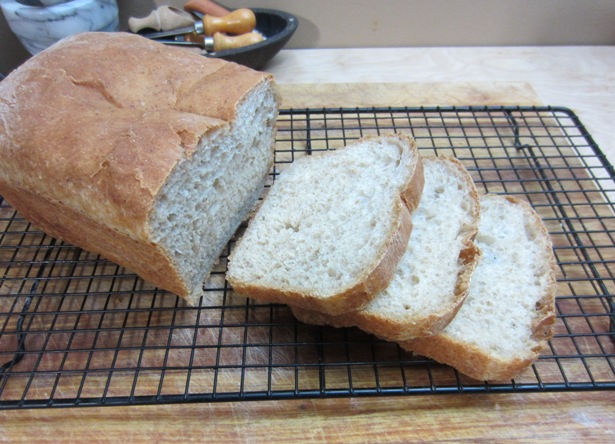I’ve been wanting to add to my “everyday loaf” repertoire where an oatmeal & molasses version has reigned supreme for quite a while. To measure up to that flavour I’ve had to resort to another grain in the mill, namely rye.
Bread from rye flour can be tricky even when mixed in small proportion with wheat flour. Rye has less gluten and competes for water more aggressively than wheat so moisture levels have to rise to compensate meaning you’ll have a wet sticky dough on your hands. I’ve been futzing with a ~13% rye mix lately and think I’ve finally gotten a ratio that gives me consistent results.
Edit 2022 February:
Pandemic supply line constraints forced a change in my brand of rye flour. This required a rework of ratios and the addition of a little malt. You might need to adjust a bit too. Rye is tricksie that way.
Also to emphasize, dough with rye flour really needs complete and thorough kneading. I call for twelve minutes and I mean it, even in a machine. Don’t be afraid to turn up the power a notch or two from what you might normally use with wheat flour. If it doesn’t make a ‘dough mass’ around the hook and just sits at the bottom of the mixer bowl, sneak in a few grams of your bench flour every time you scrape down and keep going until it eventually does “hug the hook”.
Everyday Rye Blend Loaf
350 g + 20g (bench) flour (Canadian all-purpose or “strong” or “bread” versions elsewhere)
50 g rye flour
6 g rapid rise yeast
2 g diastatic malt
10 g fine sea salt
16 g sugar
335 g warm water (335 ml but weight is more accurate with a good scale)
Yield: One delicious 9″ x 5″ loaf perfect for everything from sandwiches to toast.
Mix all the ingredients in the bowl of an upright mixer by hand just to combine, about ten strokes. Allow to sit undisturbed for ten minutes to allow the moisture to fully absorb (autolyse).
Continue to knead the fairly wet dough on medium machine speed for twelve minutes, scraping the bowl sides and bottom every two minutes. Turn out the relatively wet dough onto a well floured board allowing it to take up as little extra flour as possible to form a ball. Set aside to proof covered in a warm spot until doubled, roughly one hour. Be sure not to over-proof here.
Punch the dough down and form into a rectangle that will fit a 9″ x 5″ loaf pan. Roll the dough into a ‘log’ pinching the bottom seam tightly. Place into a well-oiled or parchment-lined pan and allow to rise again covered in an undisturbed warm spot until pillowed above the rim of the pan, roughly an hour longer. Again, watch that you haven’t let the dough over rise lest you get cavernous holes in your loaf.
Preheat the oven to 200C (400F) midway through the final rise.
Bake for fifteen minutes using steam in the first three minutes if available. Rotate the pan front to back and cover the bread with a foil tent for lighter crust as desired. Continue to bake until an internal temperature of at least 98C (208F) which can take anywhere from 15-25 minutes longer depending on your pan and oven. Remove to cool in the pan for at least twenty minutes before turning out onto a wire rack to cool completely before cutting. No cheating since the bread is still baking on the inside despite how anxious you are to get butter onto a slice.
– msh v2.2




